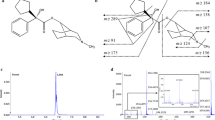Summary
To permit rational evaluation of the empirical pharmacotherapy of myasthenia with cholinesterase inhibitors, a sensitive and selective method for the determination of neostigmine has been developed. Analysis is based on ion-pair extraction of neostigmine into methylene chloride and determination by gas chromatography-mass spectrometry (chemical ionization). As neostigmine was found to be metabolized in plasma in vitro, deuterated (d6) neostigmine was immediately added to the plasma sample as the internal standard. The limit of quantitation of the method was about 1 ng/ml (∼ 3nmol/l). The kinetics following i. v. administration were studied in four patients, who received neostigmine 2.5–3.0 mg iv to antagonize pancurone administered during anaesthesia. Elimination was rapid with a half-life t1/2 (β-slope) of 0.89±0.05 h (mean ± SE). The volume of distribution was 1.08±0.11 l/kg and plasma clearance was 0.84±0.04 l/kg/h. In three fasting myasthenic patients plasma concentrations of neostigmine were followed for 5 h after a single oral dose of 30 mg. Considerable interindividual differences in absorption were expressed in the peak concentrations, which occurred 1–2 h following drug ingestion. The bioavailability of neostigmine was estimated to be 1–2% of the ingested dose. Neostigmine concentration in plasma was found to differ considerably (up to forty-fold) between myasthenic patients on their ordinary dose-schedules of cholinesterase inhibitors.
Similar content being viewed by others
References
Chan, R., Williams, N. E., Baty, J. D., Calvey, T. N.: A quantitative gas-liquid chromatographic method for the determination of neostigmine and pyridostigmine in human plasma. J. Chromatogr.120, 349–58 (1976)
Cohan, S. L., Pohlmann, L. W., Mikszewski, J., O'Doherty, D. S.: The pharmacokinetics of pyridostigmine. Neurology26, 536–39 (1976)
Goldstein, A., Aronow, L., Kalman, M.: Principles of drug action. New York: John Wiley 1974
Kornfeld, P., Samuels, A. J., Wolf, R. L., Osserman, K. E.: Metabolism of14C-labeled pyridostigmine in myasthenia gravis. Neurology20, 634–41 (1970)
Kornfeld, P., Wolf, R. L., Samuels, A. J., Osserman, K. E.: The effect of chronic pyridostigmine administration on pyridostigmine-14C metabolism in myasthenia gravis. Neurology21, 550–52 (1971)
Remen, L.: Zur Pathogenese und Therapie der Myasthenia gravis pseudoparalytica. Dtsch. Z. Nervenheilk.128, 66–78 (1932)
Sundwall, A., Vessman, J., Strindberg, B.: Fate of emepronium in man in relation to its pharmacological effects. Europ. J. clin. Pharmacol.6, 191–95 (1973)
Walker, M. B.: Treatment of myasthenia gravis with physostigmine. Lancet1934/I, 1200
Yanagisawa, S.: Patent Japan 1951:3071 (June 13). Cited from Chem. Abstr.47, 4908 (1953)
Author information
Authors and Affiliations
Rights and permissions
About this article
Cite this article
Aquilonius, S.M., Eckernäs, S.Å., Hartvig, P. et al. A pharmacokinetic study of neostigmine in man using gas chromatography-mass spectrometry. Eur J Clin Pharmacol 15, 367–371 (1979). https://doi.org/10.1007/BF00558442
Received:
Accepted:
Issue Date:
DOI: https://doi.org/10.1007/BF00558442




